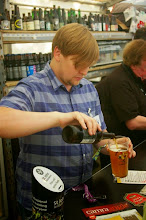I've drunk some fantastic saisons in the last year - Ilkley/Melissa Cole's rhubarb-and-vanilla Siberia, Bristol Beer Factory's zingy Saison, Wild Beer's trifecta of Epic, Bliss and Ninkasi, homebrewer Andy Parker's Nelson Saison and its bastard son the Pomegranate Saison... It's a fashionable style at the moment, and lots of people are brewing great versions of it.
I had a largely unsuccessful attempt at a saison several months ago - my main problem was that I was worried about it drying out too much and put some cara-pils in the grain bill, completely missing the point of the style. The WLP565 yeast that I used took it down to 1.010, which is not too bad considering, and the final beer was still fairly drinkable - but it wasn't quite right. After trying yet another fantastic saison - Stone/Dogfish/Victory's sublime herb-flavoured Saison du BUFF - just before Christmas, I was inspired to have another go at brewing one, if only to stop me spending so much money on them outside the house.
First of all, I decided to use WLP566 instead of 565, which is a very similar strain but anecdotally is easier to attenuate without a lot of hassle. I made up a two-litre starter 48 hours ahead to make sure I had lots of nice, healthy yeast. Secondly, I wanted to keep the grain bill very simple - 5.5kg of grain, 90% pilsner malt, 10% wheat malt. In practice, I didn't have enough of either for that, so I topped up the pilsner with regular pale and subbed the wheat for 500g of spelt malt that I bought a while back on the grounds that it was a bit of a novelty. I've never used it before, but seeing as it's very similar to wheat, I thought I'd give it a try in this.
For hops, I went the all-Nelson approach that worked so well in Andy Parker's saison, but to give it a bit of a twist, I also wanted to steal the mixed garden herbs idea from Saison du BUFF, which uses parsley, white sage, rosemary and lemon thyme at the whirlpool stage for aroma. I took the proportions from Stone's blog (although as I don't have weighing scales that are accurate to fractions of a gram, there was a lot of guesswork involved), and replaced the white sage and lemon thyme with regular garden sage and thyme, as I didn't have those to hand.
Here was the recipe for my New Year's Eve Brew - Garden Herb Saison:
Mash
3kg Pilsner Malt
2kg Pale Malt (Crisp)
500g Spelt Malt
Single infusion mash at 67C for 90 mins
Boil - 90 minutes
12g Nelson Sauvin at 90 mins
10g Irish Moss at 15 mins
38g Nelson Sauvin at 0 mins
Herb bag containing 7g fresh parsley, 3g rosemary, 3g thyme and a few sage leaves at 0 mins
Yeast - WLP566 (2l starter, made 48 hours ahead)
Notes: I wasn't sure how to treat the spelt malt, so just used it as I would wheat malt in a simple single infusion mash, which I think had an impact on efficiency. 23 litres of very pale sweet wort collected - I've managed to lose the pre-boil gravity figure but I think it was 1.050.
This was the third brew I've done on my relatively new Brupaks boiler, which I bought to replace the leaky Electrim mashing bin in my all-electric setup (although I still use the mashing bin as an HLT). It's a picky bugger though, and it kept switching itself off just short of boiling point. I think there's an issue with the thermostat but I need to investigate further. After a frustrating 10 mins of watching the thermometer hover around the 91C mark, I gave up and transferred the wort carefully into the old Electrim boiler and used that instead.
I put the finishing hops and the herbs into a hop bag so that I could fish them out as soon as the wort was almost at pitching temperature. The last few degrees of cooling and the dead-slow run off from the Electrim bin can take over an hour sometimes, and I didn't want to overdo the herbs - by the time it was down to about 25C, the herb aroma was pretty pungent, so out they came. SG was measured at 1.058 - below the 1.064 BeerTools predicted, but acceptable. Fermentation started at ambient temperature - a fairly constant 16C in the utility room - and when it began to slow down after 7 days, I ramped it up to 22C gradually using a combination of a heatpad and towels. It took a while but after 20 days, it was down to 1.008 and ready to rack to secondary.
It's currently sitting in secondary with some more Nelson Sauvin as dry hops to try and balance off the strong herb aroma, but I'm pretty happy with it so far. It should be ready for bottling in a few days, and I'll blog about how the finished beer turns out once they've conditioned.
Wednesday, 23 January 2013
Garden Herb Saison
Labels:
dogfish head,
herbs,
homebrew,
homebrewing,
nelson sauvin,
saison,
saison du buff,
stone,
wlp566
Subscribe to:
Posts (Atom)
